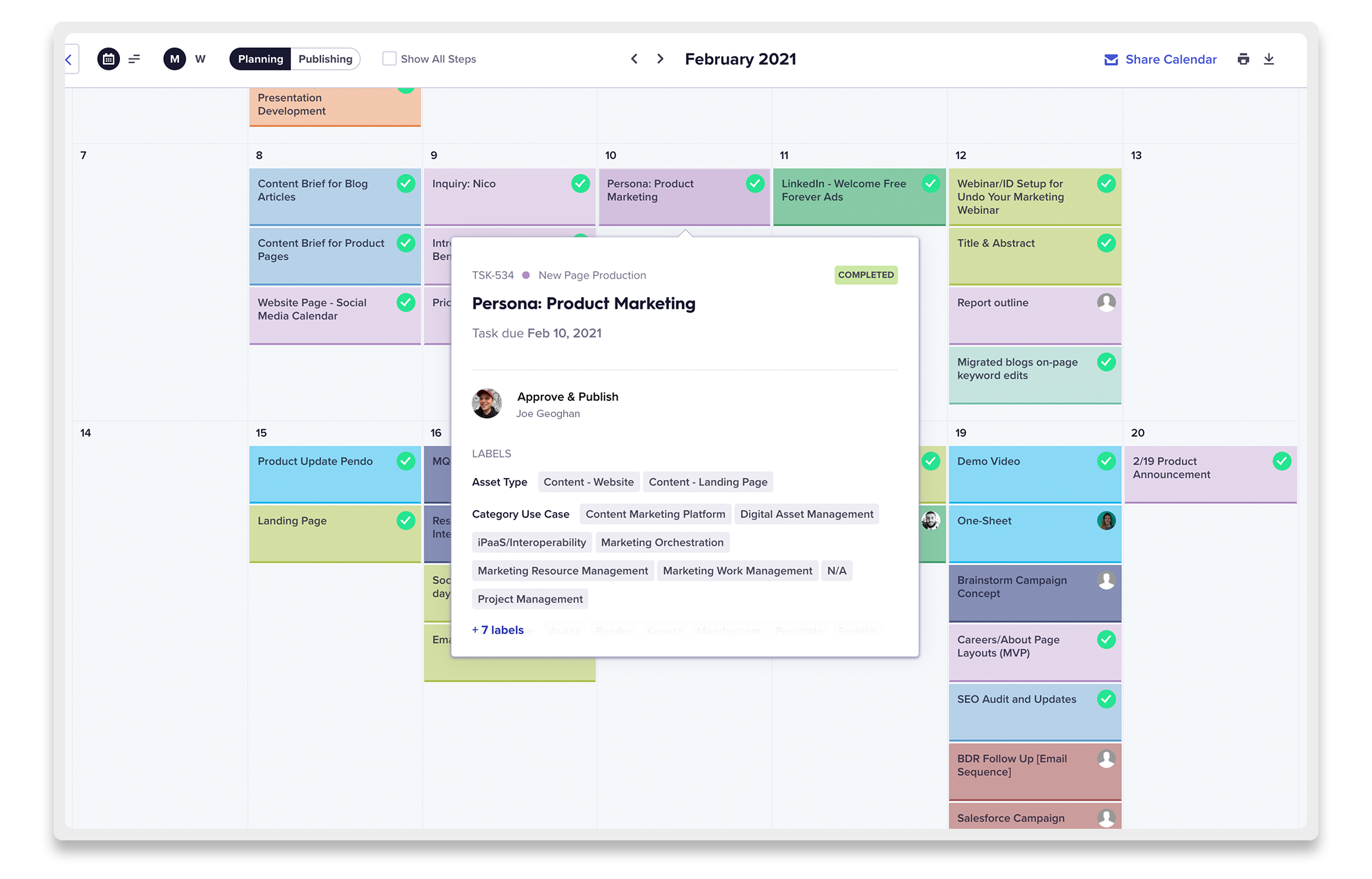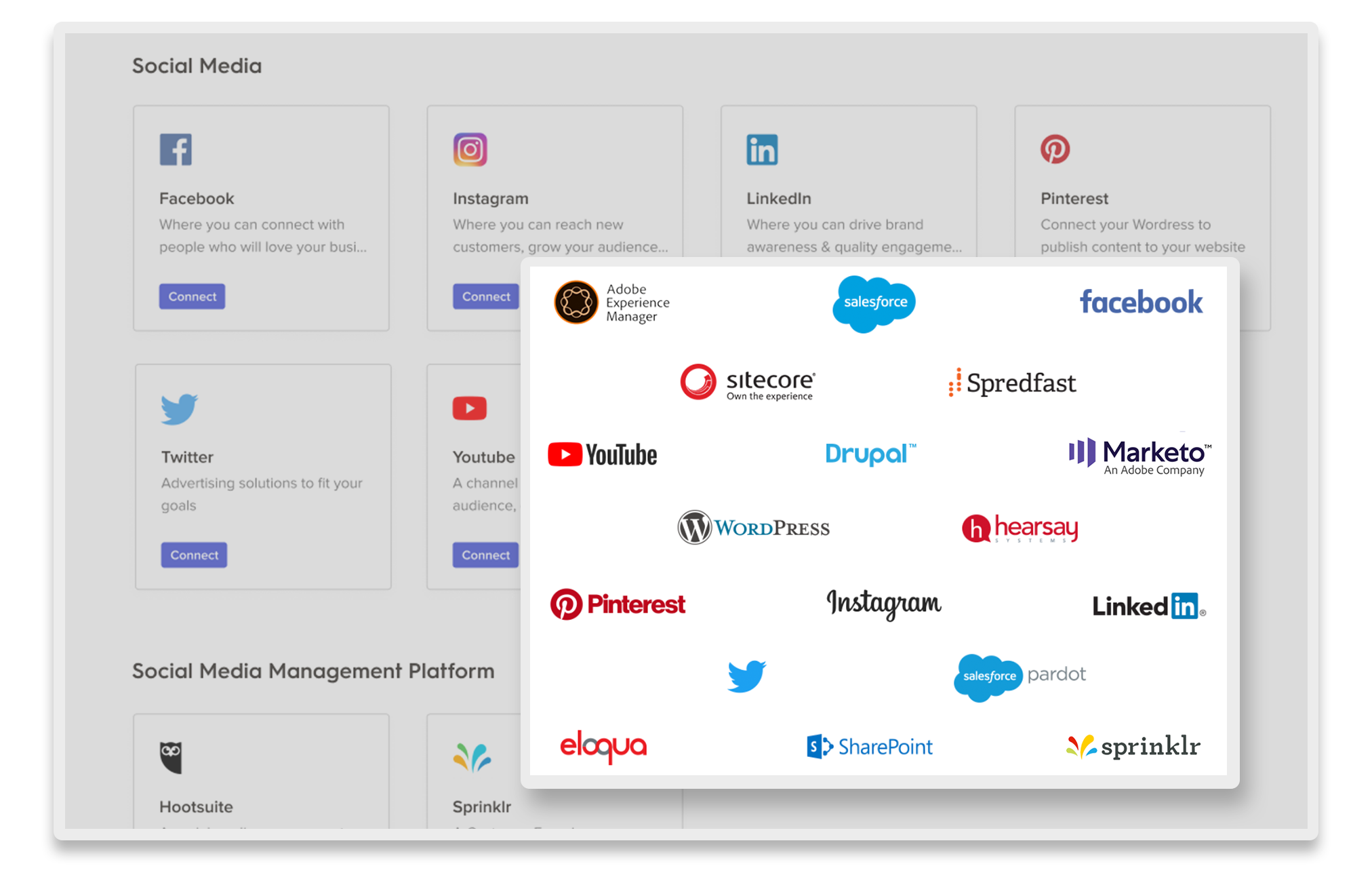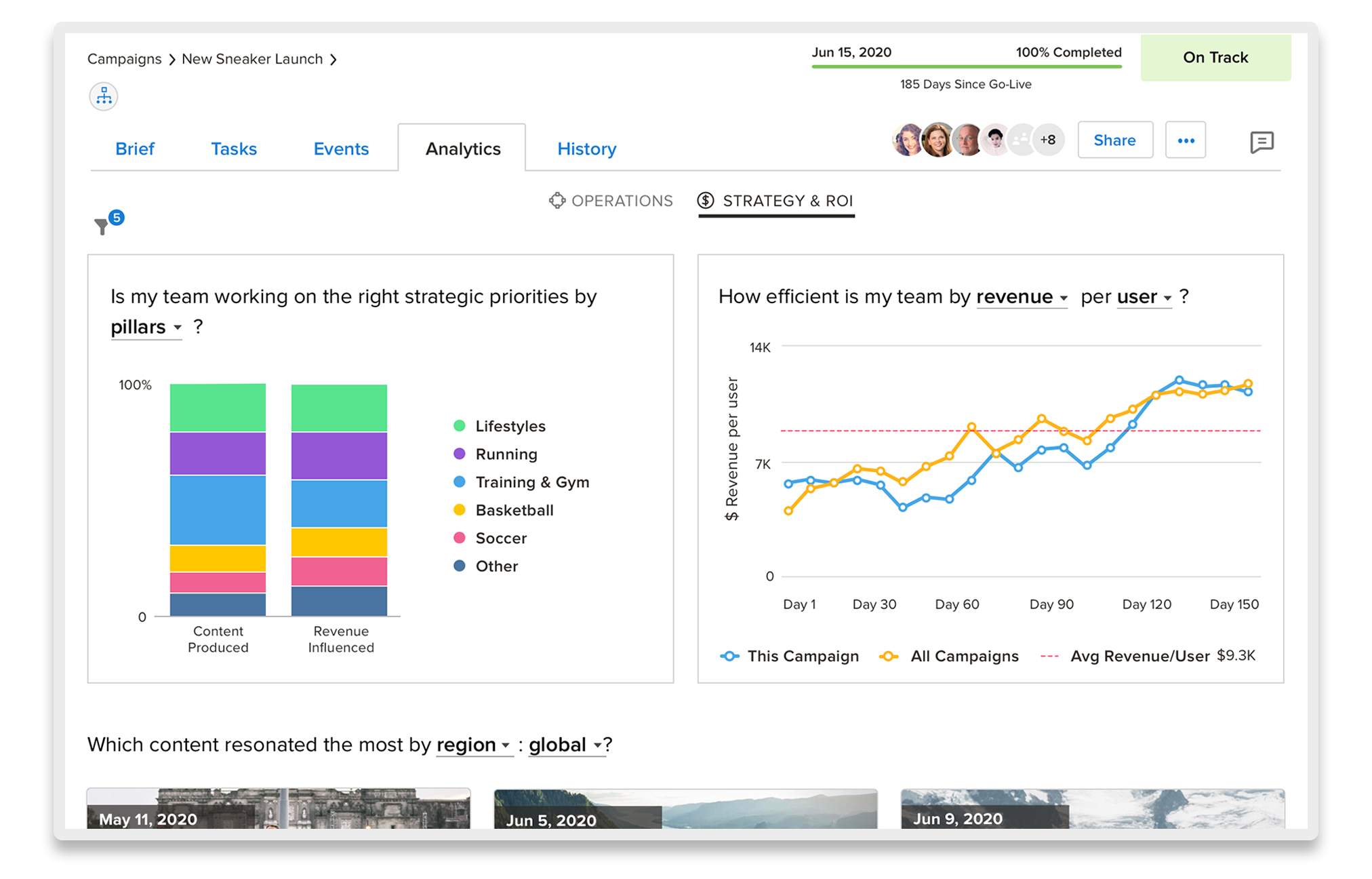Content marketing management: How to simplify the process
There's an easier way to do content marketing management. We'll show you how with Welcome's all-in-one marketing orchestration platform.

Ever since content earned a prime spot in the marketer’s playbook, content marketing management has skyrocketed in importance. Naturally, as the importance of creating content, coordinating its production, and measuring its value have increased, so have the demands on marketers.
The bad news is: content marketing management has become overly complicated. So much so sometimes that it prevents marketers from doing marketing because they’re too busy managing unintuitive tools and processes.
And now here’s the good news: we’re going to show you a better way to manage your content marketing.
Keep reading to learn:
- What challenges content marketers face as their role rises in importance
- Why the traditional martech stack isn’t the best solution for content marketing management
- How Content Marketing Platform’s marketing orchestration platform makes every step of the content marketing management process easier
The Rise of Content Marketing Management
There’s no question about it: content marketing is an indispensable part of a brand’s marketing and advertising strategy in the digital era.
Traditional forms of advertising aren’t as effective as they once were because of the decreasing popularity of old-school media.
While digital marketing and advertising let companies target potential customers with eerie precision, consumers are growing numb to ads.
In fact, an entire quarter of the U.S. population uses an ad blocker.
Companies are using content marketing to break through the noise – and the ad blockers – to reach new customers.
Because of the value placed on high-quality content, a content marketer’s role is more demanding than ever before. You have to conceptualize a strategy, conduct keyword research, produce great content, publish it, promote it, prove ROI, and manage every step of this complex process.
The Old School Martech Stack Isn’t the Best Solution for Content Marketing Management
Until recently, content marketers have had to use separate tools for each step of their workflow:
- A project management tool for organizing teams, processes, and budgets.
- A digital editorial calendar for ensuring deadlines are met.
- A keyword research tool for setting the search engine optimization strategy.
- A digital asset management (DAM) solution for storing and organizing branded visuals.
- A content creation and collaboration platform for executing the content marketing strategy.
- A CMS for publishing the website, landing pages, blog posts, and more.
- A social media platform for promoting content across social networks.
- Analytics software for measuring and proving success.
That’s – at minimum – eight different tools for one process!
That means your marketing team has to shop around for eight separate solutions. If you’re lucky, some of your marketing tools will integrate with each other.
However, more often than not, they won’t be entirely compatible, so you’ll have to spend time migrating work from one platform to another.
At the end of the day, you’ll feel like you’re not really a marketer but a software wrangler, which isn’t the best use of your talents or time. Technology is supposed to make your job easier, not create mindless tasks for you to do.
The traditional martech stack no longer cuts it in the fast-paced world of content marketing management.
Meet Content Marketing Platform: A Marketing Orchestration Platform that Makes Content Marketing Management Easy
Here’s the good news: your team can ditch that old tech stack and replace it with one tool that does it all.
Content Marketing Platform is an all-in-one marketing orchestration platform that streamlines and simplifies every step of the content marketing management process. It’s equipped with features that save you time, increase productivity, and empower your team to execute campaigns that drive results.
We’ll show you how Content Marketing Platform makes content marketing management easier.
1. Planning and Content Marketing Strategy Creation
Establishing goals and planning a strategy are the first two steps in launching a new content marketing campaign. Collaborating with key stakeholders helps ensure that every party involved will get what it expects out of the campaign.
Content Marketing Platform’s content workspace lets your team collaborate on setting goals in several ways. You can create strategy documents together in the platform’s text editor, or upload documents and annotate and comment on the files.
2. Launching Your Marketing Campaign
Now that your team has decided what it wants to accomplish with its campaign, it’s time to get organized. Content Marketing Platform can help you launch and manage campaigns seamlessly.
The platform lets you assign campaign start and end dates, color code them, and nest child campaigns within parent campaigns.
The campaign dashboard gives you a global overview of tasks, progress, and budgets. If you need more details, you can easily drill down into the child campaigns.
You can even create campaign templates in Content Marketing Platform to save time on similar projects.
Content Marketing Platform’s campaign features boost visibility into progress, keep teams aligned, and save you time.
3. Project Management
The next step in the content marketing management process requires HR and math skills: finding the right people for the job and managing budgets.
Build your dream team with Content Marketing Platform’s resource management solutions.
When tapping into your in-house talent, the platform makes it easy to keep an eye on your team’s bandwidth, so you don’t stretch them too far. And if your internal team is at capacity, you can easily get freelancers set up with access to your brand’s Content Marketing Platform license.
Content Marketing Platform simplifies managing a budget for freelancers, agencies, assets, and other expenses by showing you budgeted vs. actual spending. It also lets you manage invoices and create financial reports.
4. Setting Deadlines
The next step in the content marketing management journey is establishing timelines and milestones for your campaign. Whether your campaign involves one person or 100, you’ll need a calendar to keep deadlines straight and ensure you stay on track.
Content Marketing Platform’s marketing calendar helps you visualize every campaign, child campaign, and task. At a glance of the calendar, you can find out who is working on what and when things are due.
Instead of having to reference external calendars, everyone involved in the campaign can quickly align on deadlines thanks to this intuitive, color-coded calendar that can be organized by calendar view, timeline view, or Gantt view.
5. SEO Keyword Research
SEO is the cornerstone of content marketing. Content Marketing Platform makes it easy to identify keywords that will resonate with your target audience, and keeps your team informed about SEO successes.
The platform’s keyword research tool lets you look up keywords and understand their search volume and CPC, analyze competitors’ keywords, and more.
The beauty of having an SEO tool built into your content marketing platform (CMP) is that it allows everyone on your team to track SEO progress in real time. That means stakeholders no longer need to ask the SEO team how they’re tracking for certain keywords: it’s all right there for them to see.
6. Content Ideation
Now you need to use your keywords to devise compelling topics for your blog posts, infographics, white papers, case studies, landing pages, webinars, and any other types of content that are part of your marketing plan. Content Marketing Platform can help you come up with topics that will attract your target audience and produce results.
The platform can show you keywords that present the greatest opportunity for your brand to rank high in searches and drive traffic, keywords related to your target keywords, and the 50 most common questions related to your chosen keywords.
Use this data as inspiration for brainstorming topics for your campaign’s content.
For example, “what is B2B content marketing?” is a commonly asked question related to the keyword “content marketing.” If your brand specializes in CMP software for B2B businesses, you might be inspired to create a webinar that centers around answering that question.
The creative process isn’t linear, which is why you can save keywords in Content Marketing Platform’s digital notepad to revisit.
And if you need help crafting content ideas or want feedback from team members, the platform’s collaborative workspaces make it easy for stakeholders to provide input and build on each others’ ideas.
7. Creating High-Quality Content
Now you’ve reached the most exciting part of the content marketing management process: creating content for your target audience. Content Marketing Platform makes executing your strategy as easy as it does planning it.
Workflows
Automation is a content marketer’s best friend. You can set up workflows in Content Marketing Platform to automate processes, facilitate collaboration, and prevent approval bottlenecks.
Workflows are completely customizable, so the possibilities are endless.
We’ll walk you through how Content Marketing Platform makes managing a workflow for creating a blog post easier. Let’s say your team’s process for blogging is as follows:
Sample blogging workflow
- The editor creates a brief.
- The writer writes the first draft.
- The editor reviews the draft and asks for revisions.
- The writer makes edits.
- The editor approves the draft.
- The graphic designer creates a custom illustration for the blog’s featured image.
- The content marketing manager reviews the illustration and provides feedback.
- The graphic designer makes changes to the illustration.
- The content marketing manager approves the illustration, formats the blog post, and adds stock images to the body.
- The SEO specialist implements on-page SEO.
- The content marketing manager publishes the post.
With Content Marketing Platform, you can assign people to each step of the process and tie each step to a deadline. The platform notifies the next person in the workflow when it’s their turn, minimizing how many process-related emails and Slack messages your colleagues have to send each other.
You can easily include external collaborators in workflows by inviting them to join your team’s Content Marketing Platform workspace.
Creating Great Content
After setting up workflows, collaboration on content creation is a breeze. Now, let’s see how easy it is to draft a blog post in Content Marketing Platform, following the above sample workflow.
Your editor kicks off the process by creating a brief for the blog post in the Content Marketing Platform workspace. The editor can add labels to the project, like asset type, category use case, objective, and persona.
After the editor finishes writing or uploading the brief, they hit “complete” in the production workflow, and your writer is automatically notified that it’s their turn to get to work.
The writer reviews the brief and starts drafting the blog post in the text editor found in the workspace. The writer can upload images and format the blog within the text editor.
When happy with the draft, the writer hits “complete” in the workflow and the editor is notified that it’s time to make edits. The editor reviews the blog posts and makes simple edits via the text editor, and creates some in-line comments to flag more complicated requests for the writer.
While your content marketing manager waits for their team to produce the blog post, they can easily track progress through the editorial calendar to ensure everything is running on schedule.
8. Publication and Promotion
Content Marketing Platform simplifies the editing, publication, and content promotion processes. Here’s how.
Providing Feedback
Let’s return to our blog post example. Your editor has approved the writer’s final draft, and the graphic designer has submitted their illustration for the blog’s hero image.
Content Marketing Platform makes it easy for the content marketing manager and other stakeholders to provide feedback on the image.
Once the graphic designer uploads the illustration to the workspace, the content marketing manager can add comments, tag team members for their opinion, and even annotate the image by making markings in different colors. Reviewers can also upload attachments to their comments to show examples of what they’re looking for, or reference past iterations.
Another helpful feedback feature is a customizable brand compliance checklist that helps marketers ensure each piece of published content meets brand standards.
Adding Images
After your team approves the illustration, it’s time to add several stock photos to the body of the blog post to make it more engaging. Instead of searching several stock photo databases, you can find images directly through Content Marketing Platform’s marketplace for digital assets.
You can browse more than 200 million images from Adobe, Getty, Unsplash, Shutterstock, Twenty20, and Reuters and insert them into your content without leaving Content Marketing Platform. Filtering images by keywords, source, orientation, image style, and more lets you find the perfect photos quickly.
Pro tip: Content Marketing Platform can also help you with content curation. If you don’t have the bandwidth or resources to produce your own written content, you can license articles through Content Marketing Platform’s marketplace.
Digital Asset Management
If you’d rather use branded assets to illustrate your content, Content Marketing Platform’s library can help. The library lets your team store, manage, discover, and reuse its existing assets to ensure a consistent brand experience.
When all of your brand’s logos, images, videos, decks, audio files, and more are uploaded to one central library, access bottlenecks become a thing of the past. You’ll no longer have to waste precious time asking colleagues to send you files or miss deadlines because you’re waiting for them to share them with you.
Content Marketing Platform’s library helps you quickly find what you’re looking for with tags and search capabilities. Labels keep your team in the know about things like what content pillar an asset is meant to promote.
Want to make sure another team isn’t planning on using the same photo you’re using to illustrate a webinar as the hero image for an unrelated landing page? A publishing history timeline helps you avoid mishaps like that.
Publication
Now that you’ve formatted your blog post to perfection and the SEO wizards have worked their magic, it’s time to share this blog post with the world.
When you’re ready to hit “publish,” you can do so directly through Content Marketing Platform. The platform integrates with WordPress, Tumblr, YouTube, Facebook, Twitter, LinkedIn, and several other CMSes, CRMs, and social media marketing platforms, helping you save time and reduce errors from having to migrate your work to other publishing tools.
When sharing social media posts that link to articles on your website, you can even add URL tracking parameters to more easily track traffic and conversions.
Not sharing longform content? You can also draft, collaborate on, and publish social media posts on Content Marketing Platform.
Content Marketing Platform simplifies digital content publication by helping you collaborate on production, license assets, manage existing content, and publish it to all of your digital outposts without leaving the platform.
9. Measuring and Proving ROI
Now, the last – and arguably most important – part of the content marketing management process is measuring and proving ROI. Content Marketing Platform’s robust marketing performance capabilities let you evaluate the success of every piece of content with the help of a tracking pixel.
You can see much more than just basic metrics like page views and unique visitors. The interactive analytics functionality also provides helpful insights into how long visitors spend with the content you created and how engaging it is.
Most importantly, you can track lead generation metrics to uncover how every piece of content you publish contributes to your company’s marketing and sales funnels. Content Marketing Platform makes it easy to link each blog post, social media post, webinar, podcast, and landing page to a dollar amount.
The Bottom Line: Content Marketing Platform’s Marketing Orchestration Platforms Helps Content Marketing Managers Drive Results
Content marketers have traditionally had to rely on an overwhelming number of tools to perform their jobs, which unnecessarily complicates their work. Fortunately, content marketers now can replace their clunky martech stacks with one powerful tool.
Content Marketing Platform is a truly all-in-one marketing orchestration platform built to make content marketing management easier. Its suite of integrated solutions empowers content marketers to do their thing, and prove their value.



